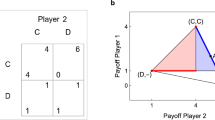Abstract
Experiments in which subjects play simultaneously several finite two-person prisoner's dilemma supergames with and without an outside option reveal that: (i) an attractive outside option enhances cooperation in the prisoner's dilemma game, (ii) if the payoff for mutual defection is negative, subjects' tendency to avoid losses leads them to cooperate; while this tendency makes them stick to mutual defection if its payoff is positive, (iii) subjects use probabilistic start and endeffect behavior.
Similar content being viewed by others
References
Andreoni, J. and Miller, J.H. (1993), Rational cooperation in the finitely repeated prisoner's dilemma: experimental evidence, The Economic Journal, 103, 570–585.
Ashlock, D., Smucker, S. and Tesfatsion, L. (1996), Referential partner selection in an evolutionary study ofthe prisoner's dilemma, BioSystems, 37.
Brock, W.A. and Hommes, C.A. (1995), Rational routes to randomness. SSRI Working Paper No. 9506, Department of Economics, University of Wisconsin.
Cachon, G.P. and Camerer, C.F. (1996), Loss-avoidance and forward induction in experimental coordination games, Quarterly Journal of Economics 111(1), 165–194.
Erev, I. and Roth, A. (1998), Predicting how people play games: reinforcement learning in experimental games with unique, mixed strategy equilibria, American Economic Review 88(4), 848–881.
Evans, G.W and Ramey, G. (1994), Expectation calculation, hyperinflation and currency collapse, in: H. Dixon N. and Rankin, (eds.), The New Macroeconomics: Imperfect Markets and Policy Effectiveness, Cambridge: Cambridge University Press.
Fudenberg, D. and Levine, D. (1995), Universal consistency and cautious fictitious play, Journal of Economic Dynamics and Control 19, 1065–1089.
Ghosh, P. and Ray, R. (1996), Cooperation in community interaction without information flow, Review of Economic Studies 63, 491–519.
Hauk, E. (1997), Breaking out: essays on partner selection in prisoner's dilemma games, Ph.D.Thesis, European University Institute, Florence.
Hauk, E. (1999), Multiple prisoner's dilemma games with(out) an outside option: an experimental study, Working Paper 391, Universitat Pompeu Fabra, Barcelona, Spain.
Hauk, E. (2001), Leaving the prison: permitting partner choice and refusal in prisoner's dilemma games, Computational Economics 18(1), 65–87.
Hauk, E. and Nagel, R. (2001), Choice ofpartners in multiple two-person prisoner's dilemma games: an experimental study. Journal of Conflict Resolution 45(6), 770–793.
Jones, B., Steele, M. Gahagan, J. and Tedeschi, J. (1986), Matrix values and cooperative behavior in the prisoner's dilemma, Journal of Personality and Social Psychology 8, 148–153.
Kreps, D.M, Milgrom, P. Robert, J. and Wilson, R. (1982), Rational cooperation in the finitely repeated prisoner's dilemma game, Journal of Economic Theory 27, 245–252.
Lave, L.B. (1965), Factors affecting co-operation in the prisoner's dilemma, Behavioral Science {pp26–38}.
Marcet, A. and Nicolini, J.P (1995), Recurrent hyperinflation and learning, mimeo, Universitat Pompeu Fabra, Barcelona.
Morikawa, T., Orbell, J.M. and Runde, A.S. (1995), The Advantage of Being Moderately Cooperative, The American Political Science Review 89(3), 601–611.
Orbell, J. and Dawes, R.M. (1991), A cognitive miser theory ofcooperators' advantage, The American Political Science Review 85(2), 515–528.
Orbell, J., Runde, A. and Morikawa, T. (1996), The robustness of cognitively simple judgements in ecologies of prisoners' dilemma games, BioSystems 37, 81–97.
Orbell, J., Schwartz-Shea, P. and Simmons R.T. (1984), Do cooperators exit more readily than defectors?, The American Political Science Review 78, 147–162.
Orbell, J.M. and Dawes, R.M. (1993), Social welfare, cooperators' advantage and the option ofnot playing the game, American Sociology Review 58, 787–800.
Peck, J.R. (1993), Friendship and the evolution of co-operation, Journal of Theoretical Biology 162, 195–228.
Rapoport, A. and Chammah, A.M. (1965), Prisoner's Dilemma: a Study in Conflict and Cooperation, Ann Arbor Paperbacks, University of Michigan Press.
Roth, E. and Murnighan, K. (1978), Equilibrium behavior and repeated play of the prisoner's dilemma, Journal of Mathematical Psychology 17, 189–198.
Sally, D. (1995), Conversation and cooperation in social dilemmas: a metaanalysis of experiments from 1958 to 1992, Rationality and Society 7, 58–92.
Schluessler, R. (1989), Exit threats and cooperation under anonymity, Journal of Conflict Resolution 33(4), 728–749.
Selten, R. and Stoecker, R. (1986), End behavior in sequences offinite prisoner's dilemma supergames, Journal of Economic Behavior and Organization, 7, 47–70.
Steele, M. and Tedeschi, J. (1967). Matrix indices and strategy choices in mixedmotive games. Journal of Conflict Resolution 11, 198–205.
Smucker, M.D., Stanley, E.A. and Ashlock, D. (1994). Analyzing social network structures in the iterated prisoner's dilemma with choice and refusal, Technical Report CS-TR-94-1259 30, University of Wisconsin, Madison, WI.
Stanley, E.A., Ashlock, D. and Tesfatsion, L. (1994), Iterated Prisoner's Dilemma with Choice and Refusal of Partners, in: C. Langton, (ed.), Artifical Life III. pp. 131–175. Vol. 17. SFI Studies in the Sciences of Complexity. Reading, MA: Addison-Wesley.
Tesfatsion, L. (1997)., A trade network game with endogenous partner selection, in: H. Ammon, B Rustem and A.B. Whinston (eds.), Computational Approaches to Economic Problems, pp. 249–269. Dordrecht, The Netherlands: Kluwer.
Tversky, A. and Kahnemann, D. (1991). Loss avoidance in riskless choice: a reference dependent model, Quarterly Journal of Economics 106(4), 1093–1061.
Author information
Authors and Affiliations
Rights and permissions
About this article
Cite this article
Hauk, E. Multiple Prisoner's Dilemma Games with(out) an Outside Option: an Experimental Study. Theory and Decision 54, 207–229 (2003). https://doi.org/10.1023/A:1027385819400
Issue Date:
DOI: https://doi.org/10.1023/A:1027385819400




